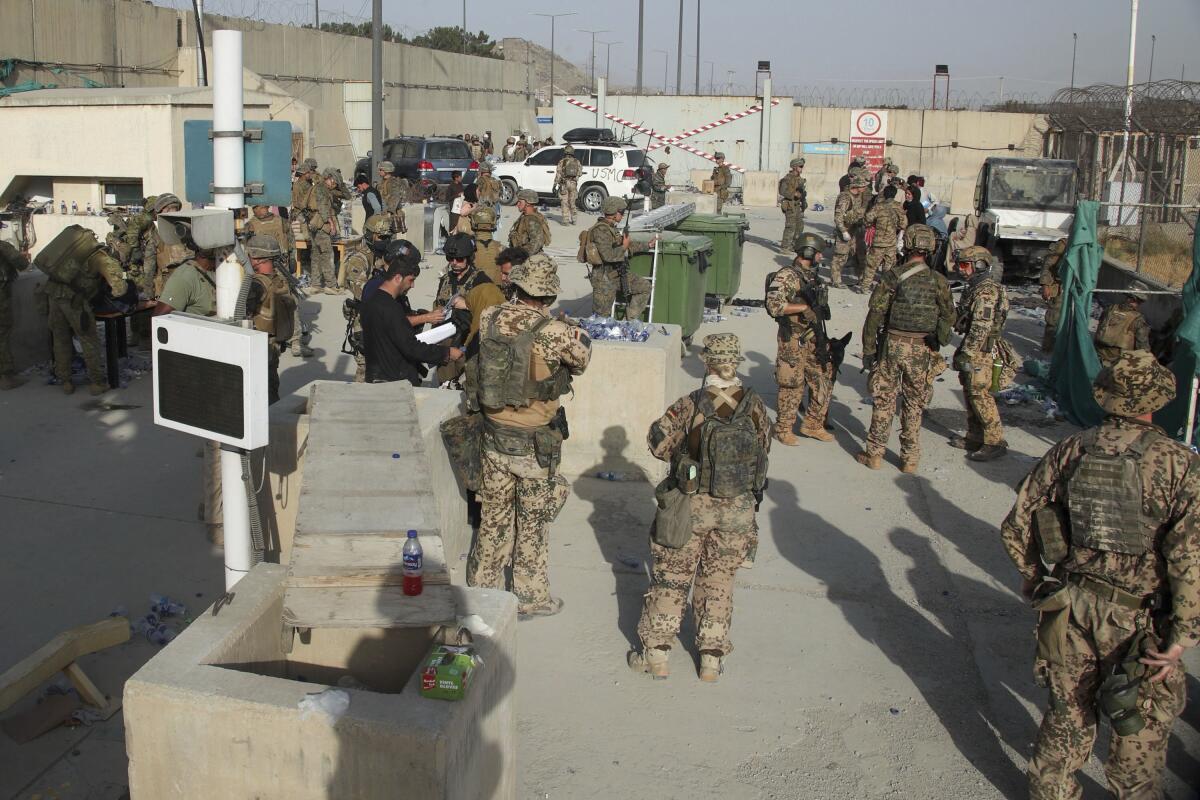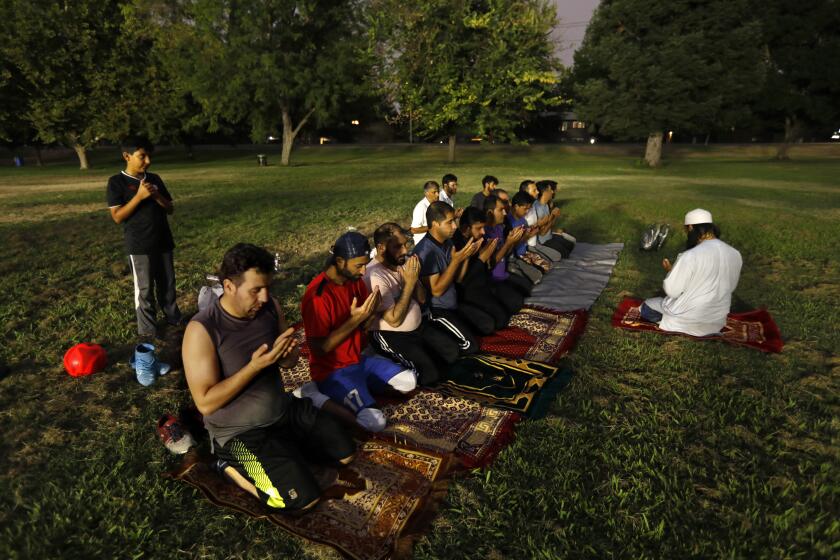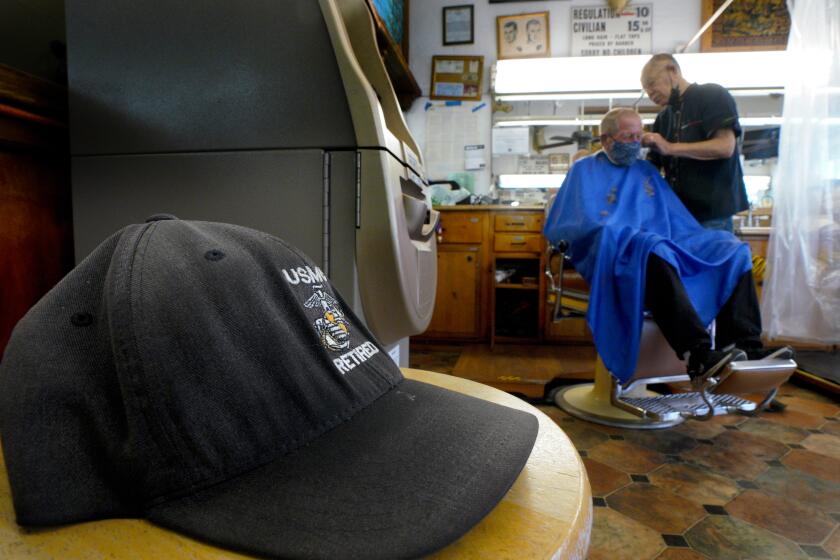7 Afghans die amid chaos at Kabul airport as U.S. orders airlines to assist with airlifts

- Share via
KABUL, Afghanistan — The pandemonium around Kabul’s airport turned deadly Sunday, with seven people killed in the chaotic, thousands-strong scrum to reach evacuation flights out of Afghanistan.
“Our sincere thoughts are with the families of the seven Afghan civilians who have sadly died in crowds in Kabul,” the United Kingdom’s defense ministry said in a statement. “Conditions on the ground remain extremely challenging but we are doing everything we can to manage the situation as safely and securely as possible.”
The deaths came as the U.S. Embassy warned its citizens to stay away from Hamid Karzai International Airport unless specifically instructed otherwise, citing risks of attack by Islamic State militants operating in Afghanistan, who are avowed enemies of the Taliban.
But rather than Islamic State, the more immediate danger has been the chaos around the airport, where thousands gather daily at the gates in an increasingly frantic attempt to escape Afghanistan with the Taliban now in control.
The Taliban entered Kabul seven days ago in the culmination of a blitz offensive that saw it take — with seemingly little effort — almost all of the country. The group has exhorted people to stay, promising amnesty for officials of the former government, its armed forces as well as those who worked with its international allies. It has also spoken of reconciliation and the promise to grant women a role in state affairs.
Yet few seem willing to gamble on the Taliban’s sincerity, amid reports of door-to-door searches and compilation of lists of its now-defeated adversaries in the security and intelligence services — signs that hint at retribution to come.
Latifa Ainy, a women’s rights activist in Kabul and mother of two, said Taliban fighters searched her home Saturday and beat her husband in front of her and their young daughters. He remained hospitalized Sunday. “Some person told them about me, my work with women,” Ainy said via WhatsApp on Sunday. “My husband didn’t let them hurt us. I am at home now but my life is at risk. I don’t know what I can do. We have to leave Afghanistan.”
Outside the airport, far from presenting a gentle face to a population already in fear, the Taliban’s foot soldiers have instead used ropes, whips, sticks, rifle butts as well as shooting in the air in a crude form of crowd control. Some critics say they’re only doing the work the Americans and their allies should be doing — and that in any case it’s necessary only as a result of botched evacuation plans.
Those who do make it past the gates speak of confusing instructions, a days-long wait inside the terminal as well as evacuation flights leaving with empty seats.
As the Taliban solidifies control of Afghanistan, Californians with friends and family in the country are scrambling to help.
Military planners remain committed so far to the Aug. 31 withdrawal deadline, although President Biden said Wednesday that he would be willing to maintain a presence until every American is evacuated. Washington now has about 6,000 troops in the country, but there are still no plans to extend its area of operations beyond the airport’s perimeter and create safe passage. And few believe the U.S. is able to finish processing and evacuating foreign citizens and those with the necessary paperwork — thought to number more than 70,000 — in time to leave.
“If the U.S. timetable remains, we have no time to lose to get the majority of the people waiting out,” wrote U.K. Defense Secretary Ben Wallace in the British newspaper Mail on Sunday. “Perhaps the Americans will be permitted to stay longer, and they will have our complete support if they do.”
Defending his handling of the U.S. exodus from Afghanistan, Biden said Sunday that military commanders are working to ease access to the airport in Kabul, including possibly expanding the security perimeter around the facility as worry grows over possible attack by Islamic State militants.
Biden refused to discuss “tactical changes” being taken in the rescue operations but suggested that Americans and other potential evacuees may be moved from where they live or are sheltering to a second, safe site before being taken to the airport. That suggests a more robust U.S. military operation outside the airport, but the details remained unclear.
Biden again said he would consider extending the Aug. 31 deadline for ending the withdrawal, and he emphasized that all Afghans who are not U.S. citizens or permanent residents will not be transported directly from Kabul to the U.S. but will undergo a full vetting at a third location.
He said about 33,000 Americans and allies have been airlifted out of the country since the end of July and the number of flights is increasing.
The evacuation, Biden added, would have been “hard and painful” regardless of when it began, a month ago, a month from now.
“We see no reason we can’t keep this tempo up,” he said at a news conference at the White House.
“We have a long way to go, and a lot can still go wrong.”
U.S. Secretary of State Antony J. Blinken said Sunday that the situation at the airport in Kabul remained “incredibly volatile” and “fluid” but that the U.S. military succeeded in airlifting 8,000 more people out of Afghanistan on 60 flights in the last 24 hours, bringing to around 30,000 the number of people transported since the end of July. He did not update the number of U.S. citizens in that total; two days earlier it was about 2,500.
Blinken and other administration officials faced questioning Sunday on the difficulty for Americans and eligible Afghans to reach the airport.
National security advisor Jake Sullivan said on CNN that “alternative methods” had been developed to help people leaving the country get past Taliban checkpoints into the airport. He did not elaborate.
“We’re in direct contact with Americans and others to help guide them to the airport, right place, right time, to get in more safely and effectively,” Blinken said on “Fox News Sunday.”
“We will do what is necessary to get Americans who want to leave out of harm’s way and get them home,” Blinken added when asked if U.S. helicopters had conducted additional rescue operations outside of the airport. One such mission, to pick up 169 Americans stuck at a hotel near the airport, was revealed last week by Biden, but Pentagon and State Department officials have declined to comment further.
Speaking later to CBS’ “Face the Nation,” Blinken repeated that establishing direct contact with Americans in Afghanistan was the administration’s first order of business in accelerating rescue missions.
The beach city of Oceanside blossomed over the decades as tens of thousands of Marines trained at Camp Pendleton and veterans returned to live nearby. A somber mood has taken the town as residents watch scenes of chaos in Kabul.
“The best way, the most effective way, the way I’m focused on to get folks in, again, is to be in direct contact with them and to help guide them and to give them instructions on where to go, when to go there, and then we can bring them into the airport safely and effectively,” Blinken said.
The administration on Sunday also ordered commercial airlines to assist in the evacuation. They won’t fly passengers out of Kabul but between the roughly two dozen countries on four continents that have agreed to accept Afghans at least temporarily. The “activation order” will involve 18 aircraft from American Airlines, Atlas Air, Delta Air Lines, United Airlines, Omni Air and Hawaiian Airlines.
Sullivan, on CNN, also confirmed that an additional point of tension at the Kabul airport was what he called an acute and real threat of attack from an offshoot of the Islamic State militant group operating in Afghanistan.
Still, the difficulties continue outside the country, with the U.S. working to find a halfway point to temporarily house the thousands of Afghans flown out every day. Last week, evacuation flights were temporarily halted after Qatar said it had reached capacity, sending officials scrambling to find an alternative destination.
One could glimpse the massive logistical undertaking involved in the evacuation at Qatar’s Al-Udeid, a sprawling military air base on the outskirts of the capital, Doha. On Sunday, the airfield was a site of constant activity, with queues of dark-gray U.S. military transport aircraft and the banshee scream of Qatari Air Force Rafale jets streaking into the distance.
At the passenger terminal, Qatari and American soldiers, shaggy-bearded contractors sporting sunglasses and stone-faced special forces types seeking air-conditioned sanctuary from the broiling heat outside were crammed into the hallway beside a pile of Afghan refugees’ suitcases. Beyond the security barrier where they stood, a gaggle of young Afghan girls in brightly colored clothes played on the floor.
By Sunday, Spain said it would allow the U.S. to use two military bases on its territory to host Afghan refugees. Others would be sent to Kuwait and Bahrain.
Meanwhile, the drama of the escape persisted even on the flights. On Sunday, a pregnant woman on a U.S. Air Force C-17 headed to Ramstein Airbase in Germany went into labor. She began experiencing complications, forcing the pilot “to descend in altitude to increase air pressure in the aircraft, which helped stabilize and save the mother’s life,” according to a Twitter thread from the U.S. Air Mobility Command.
“Upon landing, airmen from the 86th MDG came aboard and delivered the child in the cargo bay of the aircraft,” the tweets said. “The baby girl and mother were transported to a nearby medical facility and are in good condition.”
Far from the chaos at the gates, all was calm efficiency on the tarmac of Kabul airport, where hundreds of Afghan men, women and children lined up in silence, then trudged past burly soldiers bunkered in mine-resistant vehicles before being swallowed by the rear of the transport aircraft. In a penned yard to the side, Afghan families squatted among dozens of crumpled plastic bottles and discarded MREs. The mood was somber.
“We didn’t want to leave, but we had to,” said Qiyam, a 30-year-old employee of the German Press Agency. At his feet was a backpack and a carry-on case, the sum total of the belongings he had managed to take with him on this one-way journey. “These are Afghanistan’s best and brightest, and they’re all leaving. It will take two decades for the country to recover from this.”
Toward the rear of the line sat Farah, a 22-year-old medical university student, her eyes red from what must have been hours of crying. Her university had arranged for her to continue her studies in Sulaymaniyah, in northern Iraq. But it was little solace for her.
“All my dreams are destroyed,” she said, choking on the words. “No matter where we go, no matter how beautiful the country we’re going to will be, it’s not like my country. It’s not like home.”
Times staff writers Tracy Wilkinson in Washington and Molly Hennessy-Fiske in Houston contributed to this report.
More to Read
Sign up for Essential California
The most important California stories and recommendations in your inbox every morning.
You may occasionally receive promotional content from the Los Angeles Times.













